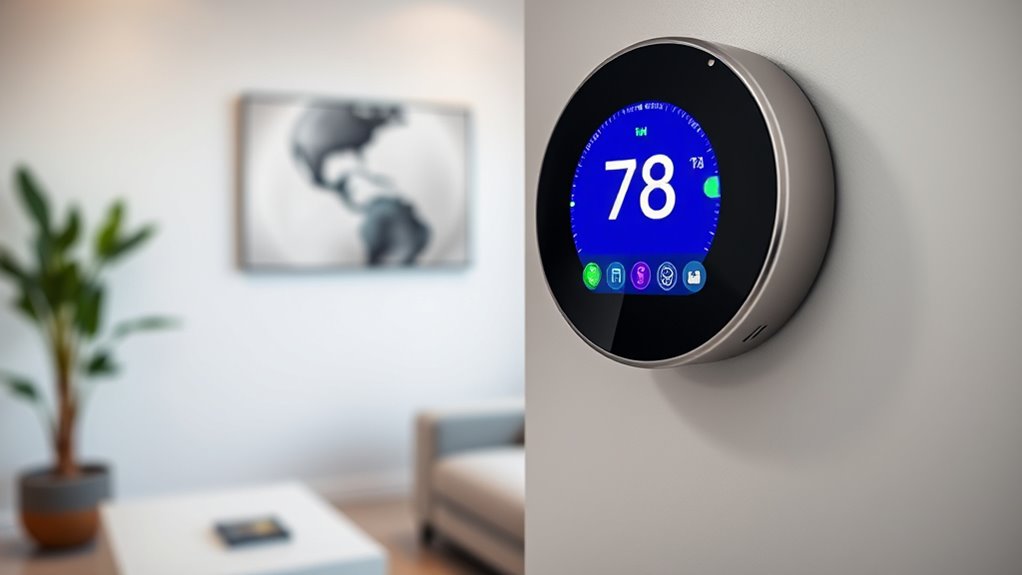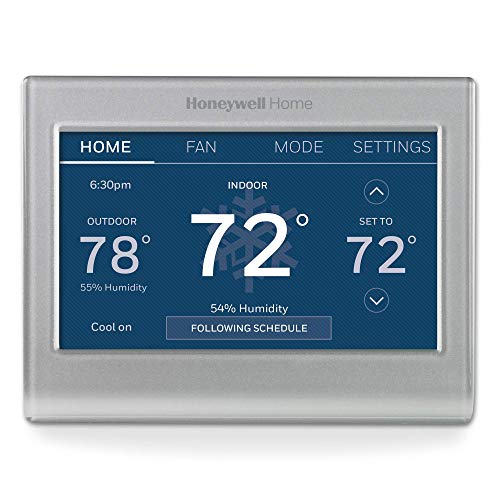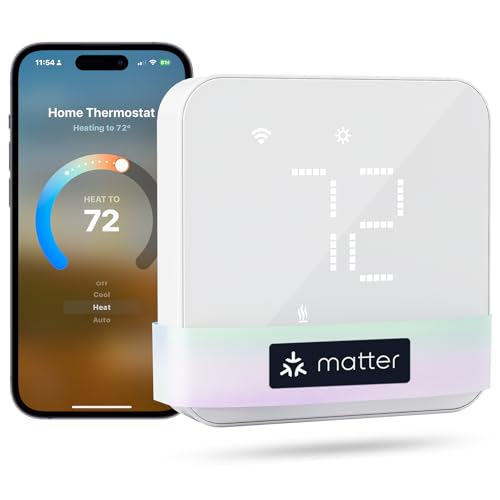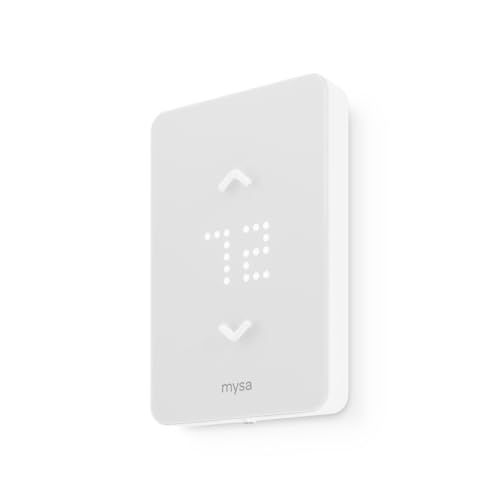If you’re looking to upgrade your heat-only system, I’ve found that smart thermostats like Sensi, ecobee, Honeywell, and Nest offer great features to maximize comfort and save energy. They’re compatible with most heat systems, easy to install, and can be controlled remotely through apps or voice assistants. With smart scheduling, learning capabilities, and energy reports, these models help reduce costs while maintaining the perfect temperature. Keep exploring—there’s more to learn about choosing the right one for your home.
Key Takeaways
- Compatibility with heat-only systems like electric baseboards, boilers, and furnaces ensures optimal control and energy savings.
- Features such as smart scheduling, occupancy sensing, and adaptive learning maximize comfort while reducing energy costs.
- Easy DIY installation with wiring options like C-wires and Power Extender Kits simplifies setup for various heating systems.
- Integration with voice assistants and remote app control allows convenient management of heating from anywhere.
- ENERGY STAR certified models offer verified energy efficiency, potential savings, and advanced user-friendly interfaces.
Sensi Smart Thermostat with Wi-Fi and Alexa Compatibility
If you’re looking for a reliable, easy-to-install thermostat for your heat-only system, the Sensi Smart Thermostat with Wi-Fi and Alexa compatibility is an excellent choice. Made by Emerson with a century of HVAC expertise, it fits most residential systems, including boilers and furnaces, without needing a common wire. Its straightforward setup uses a built-in level and clear instructions, often completing installation in minutes. The mobile app allows remote control, scheduling, and energy reports, helping you save around 23% on energy. Plus, its sleek design, privacy focus, and compatibility with voice assistants make it a smart, user-friendly upgrade for your heating system.
Best For: homeowners seeking an easy-to-install, energy-efficient smart thermostat compatible with heat-only systems like boilers and furnaces without requiring a common wire.
Pros:
- Simple DIY installation with clear instructions and built-in level
- Compatible with most residential HVAC systems, including two-wire setups
- Helps reduce energy costs by approximately 23% with remote access and smart scheduling
Cons:
- No support for Bixby voice assistant
- Slight delay (~20-25 seconds) between temperature adjustment and system response on some systems
- Limited compatibility with certain advanced multi-zone or complex HVAC configurations
Sensi Lite Smart Thermostat
The Sensi Lite Smart Thermostat stands out as an excellent choice for homeowners with heat-only systems, thanks to its compatibility with boilers, furnaces, and heat pumps. It’s Energy Star certified, easy to install in about 10 minutes, and offers Wi-Fi control via a user-friendly app. You can schedule, monitor, and manage your heating remotely, and it works seamlessly with Alexa, Google Assistant, and SmartThings. Its simple black design with LCD display fits well into any home. Special features like auto changeover, humidity display, and filter indicators help maximize comfort and efficiency. Plus, its privacy-focused approach keeps your data safe while saving energy.
Best For: homeowners seeking an easy-to-install, energy-efficient smart thermostat compatible with heat-only systems like boilers and furnaces.
Pros:
- Simple 10-minute DIY installation with clear instructions and built-in level
- Compatible with multiple smart home platforms including Alexa, Google Assistant, and SmartThings
- Energy Star certified, providing potential savings of approximately 23% on HVAC costs
Cons:
- May require rewiring existing C-wire connections for certain heating systems
- Occasional connectivity or wiring recognition issues, especially with older HVAC setups
- Customer support experiences can vary, with some users facing delays in troubleshooting
ecobee Smart Thermostat Enhanced Programmable Wifi Thermostat
The ecobee Smart Thermostat Enhanced stands out as an excellent choice for homeowners with prevalent 24 VAC heat-only systems, since it seamlessly integrates with most of these setups while offering advanced energy-saving features. It can save up to 26% annually by adjusting temperature based on occupancy, sleep, and away modes, and preheats or precools your home before arrival. Compatible with most HVAC systems, including gas, oil, electric, and boilers, it includes a Power Extender Kit for homes without a C-wire. Controlled via app or voice, it offers remote management, occupancy sensors, and humidity control, making it a versatile, energy-efficient upgrade for your heat-only system.
Best For: homeowners with 24 VAC heat-only HVAC systems seeking an energy-efficient, smart thermostat with easy installation and remote control capabilities.
Pros:
- Compatible with most 24 VAC heating systems, including gas, oil, electric, and boilers
- Offers automatic energy savings up to 26% annually through occupancy, sleep, and away modes
- Includes a Power Extender Kit (PEK) for easy installation without a C-wire
Cons:
- Professional installation recommended if no C-wire is available, which may add to setup costs
- Some users report display issues or website login inconveniences
- May require careful wiring inspection to ensure compatibility, especially in complex systems
Honeywell Home Smart Thermostat with WiFi Compatibility
For homeowners with conventional heating systems, the Honeywell Home Smart Thermostat with WiFi Compatibility stands out as a versatile and user-friendly choice. It supports a range of systems, including conventional and heat pump setups, with easy wall mounting and simple wiring—C-wire or an adapter is recommended. The thermostat offers remote control via the First Alert app, customizable schedules, and voice commands through Alexa, Google Assistant, and Apple HomeKit. Its ENERGY STAR certification guarantees efficiency, while interchangeable decorative pieces let you match home decor. Despite some WiFi setup quirks, its reliability, flexibility, and smart home integration make it an excellent option for maximizing comfort and energy savings.
Best For: homeowners with conventional or heat pump heating systems seeking an easy-to-install, customizable, and smartly integrated thermostat for energy efficiency and remote control.
Pros:
- Compatible with a variety of conventional and heat pump systems, including in-floor heating setups.
- Supports WiFi connectivity, remote control via app, voice commands, and smart home platform integration (Alexa, Google, Apple HomeKit).
- ENERGY STAR certified, with customizable scheduling and decorative options to match home decor.
Cons:
- WiFi setup can be finicky and may require troubleshooting or support.
- App features have limitations, such as needing horizontal scrolling and portrait mode only on tablets.
- Some users experience connectivity issues or limited advanced automation within the HomeKit environment.
RTH9585WF1004 Wi-Fi Smart Color Thermostat
If you’re looking for a versatile and customizable thermostat to optimize heat-only systems, the RTH9585WF1004 Honeywell Home Wi-Fi Smart Color Thermostat stands out. Its 7-day programmable, touchscreen design and Energy Star certification make it a practical choice. I appreciate the customizable color display and intuitive controls, which make setup and daily adjustments straightforward. It supports various heating types, including forced air, hot water, and steam, and integrates seamlessly with Alexa for voice commands. Its smart response technology learns your schedule, helping improve efficiency while maintaining comfort. Plus, remote control via smartphone makes managing your heating system convenient from anywhere.
Best For: homeowners seeking a customizable, energy-efficient Wi-Fi smart thermostat compatible with various heating systems and voice control.
Pros:
- Customizable color touchscreen and sleek design for easy personalization and aesthetics
- Supports multiple heating types including forced air, hot water, and steam, with smart response technology for efficiency
- Remote control via smartphone app and seamless Alexa integration for hands-free operation
Cons:
- Installation can be challenging due to delicate wiring connectors requiring careful handling
- Some users report discrepancies in humidity measurement and lag in humidity readings
- No electric baseboard heat support and requires a C-wire for power, which may not be available in all setups
Amazon Smart Thermostat
Designed for homeowners with conventional 24V HVAC systems, the Amazon Smart Thermostat offers an affordable and user-friendly upgrade that makes managing heat-only systems simple. It’s compatible with most 24V setups, including force air, heat pumps, and radiant boilers, but not suitable for 110-240V systems like electric baseboard heat. Easy to install via the Alexa app, it requires a C-wire or a power adapter kit (sold separately). Made with Honeywell technology and ENERGY STAR certified, it helps save around $50 annually on energy bills. Its sleek, modern design, voice control via Alexa, and smart features make it a practical choice for upgrading traditional heating controls.
Best For: homeowners with conventional 24V HVAC systems seeking an affordable, easy-to-install smart thermostat with voice control and energy-saving features.
Pros:
- User-friendly installation and setup via the Alexa app
- Compatible with most 24V HVAC systems, including heat pumps and radiant boilers
- ENERGY STAR certified, helping to save approximately $50 annually on energy bills
Cons:
- Requires a C-wire or separate power adapter kit for installation
- Some users experience network reconnection issues after power outages or firmware updates
- Limited compatibility with 110-240V systems like electric baseboard heat
Sensi Touch 2 Smart Thermostat with Touchscreen
The Sensi Touch 2 Smart Thermostat with Touchscreen is an excellent choice for homeowners seeking a sleek, user-friendly device that simplifies controlling heat-only systems. Its color LCD touchscreen makes adjustments intuitive, while Wi-Fi connectivity allows remote operation from anywhere. Compatible with popular voice assistants like Alexa and Google Assistant, it integrates seamlessly into smart home setups. Easy to install with an app-guided process, it supports scheduling, geofencing, and room sensors for balanced comfort. The thermostat promotes energy savings—reducing HVAC use by about 23%—and offers detailed usage reports. With a 3-year warranty and privacy-focused design, it’s a reliable, modern solution for efficient home heating control.
Best For: homeowners seeking a sleek, easy-to-use smart thermostat that offers remote control, energy savings, and seamless smart home integration.
Pros:
- Intuitive touchscreen interface and app for effortless setup and adjustments
- Supports scheduling, geofencing, and room sensors for customized comfort
- Compatible with Amazon Alexa, Google Assistant, and Samsung SmartThings for voice control and automation
Cons:
- Requires a C-wire for installation, which may not be available in all homes
- Wi-Fi setup can sometimes be challenging, especially with PIN management
- Limited to heating and cooling systems that are compatible, potentially requiring additional wiring or adapters
ecobee Smart Thermostat Essential with Wi-Fi and Voice Compatibility
For homeowners looking to optimize their heat-only systems without complicated wiring, the ecobee Smart Thermostat Essential offers a straightforward solution. It can save up to 23% annually on heating and cooling costs by adjusting settings based on your schedule. The thermostat automatically conserves energy when you’re away and boosts comfort when you’re home. It’s compatible with 85% of HVAC systems and easy to install—no C-wire needed, thanks to the Power Extender Kit. The color touchscreen makes temperature adjustments simple, and it integrates seamlessly with Apple HomeKit, Google Assistant, and Alexa for voice control. Plus, free software updates keep it current and performing well.
Best For: homeowners seeking an easy-to-install, energy-efficient smart thermostat compatible with their existing HVAC system without the need for a C-wire.
Pros:
- Easy DIY installation with no C-wire required using the Power Extender Kit
- Compatible with major smart home platforms like Apple HomeKit, Google Assistant, and Alexa
- Automatic energy savings of up to 23% annually through scheduling and remote monitoring
Cons:
- Compatible with 85% of HVAC systems, so some systems may require additional checks
- Limited to heat-only systems, which may not suit homes with cooling needs
- Basic features may lack advanced customization found in higher-end models
meross Smart Thermostat for Home
If you’re looking to upgrade your heat-only system with a smart thermostat that offers easy integration and energy savings, the meross Smart Thermostat for Home is an excellent choice. It’s compatible with 95% of HVAC systems, including traditional heating, cooling, and heat pumps, though not electric baseboard heaters. Installation is straightforward, especially with the included wiring stickers and backplate, but you’ll need a C-wire or the Meross adapter. It supports Wi-Fi, Matter, Alexa, Apple HomeKit, Google Assistant, and SmartThings, allowing remote control and voice commands. With smart scheduling, usage monitoring, and a sleek design, it’s a reliable, budget-friendly upgrade for modern homes.
Best For: homeowners seeking an easy-to-install, energy-efficient smart thermostat compatible with a wide range of HVAC systems and smart home platforms.
Pros:
- Supports multiple smart home integrations including Alexa, Apple HomeKit, Google Assistant, and SmartThings.
- Easy installation with included accessories and straightforward wiring process.
- Offers smart scheduling, remote control, and energy monitoring features to optimize usage and reduce bills.
Cons:
- Requires a C-wire or adapter for proper operation, which may involve additional setup.
- Not compatible with electric baseboard heaters.
- Some users have experienced minor wiring or setup confusion, especially with Matter integration.
ecobee Smart Thermostat Premium with Sensors and Air Quality Monitor
Homeowners seeking to optimize heating efficiency and indoor air quality will find the ecobee Smart Thermostat Premium with Sensors and Air Quality Monitor an excellent choice. It can save up to 26% annually on heating and cooling costs, thanks to its ENERGY STAR certification and SmartSensor technology that targets key rooms. The built-in air quality monitor alerts me to poor air conditions and offers helpful tips, while the thermostat also acts as a home security hub with smoke detection, security alerts, and temperature drop notifications. Its sleek design, vibrant display, and occupancy sensing make it both practical and stylish, plus it supports voice control via Alexa, Siri, and Google Assistant.
Best For: homeowners seeking to enhance energy efficiency, indoor air quality, and smart home integration with a versatile, stylish thermostat.
Pros:
- Saves up to 26% annually on heating and cooling costs with energy-efficient operation.
- Built-in air quality monitor and home monitoring features for healthier, safer indoor environments.
- Supports voice control via Alexa, Siri, and Google Assistant, plus stylish and intuitive design.
Cons:
- Requires an ecobee Smart Security plan for certain advanced security and sensor features.
- Compatibility limited to most 24VAC HVAC systems; some older systems may not be compatible.
- The installation may require additional components like the Power Extender Kit for C-wire-less setups.
Vine Smart Thermostat with Touchscreen Display
The Vine Smart Thermostat with Touchscreen Display stands out as an excellent choice for those seeking a modern, user-friendly control experience for their heat-only systems. Its 2.8-inch color touchscreen offers easy navigation, while WiFi connectivity enables remote control via the Vine app or Smart Life. Compatible with Alexa, Google Assistant, Android, and iOS, it supports a wide range of heating systems, including conventional, heat pump, gas, electric, and oil sources, all requiring a C-wire. Installation is straightforward, taking about 20 minutes. With features like programmable schedules, auto modes, geofencing, and energy-saving options, this thermostat combines convenience, flexibility, and smart functionality.
Best For: homeowners seeking an easy-to-install, touchscreen smart thermostat compatible with various heating systems and voice assistants.
Pros:
- User-friendly 2.8-inch color touchscreen display for intuitive navigation
- Wide system compatibility, including conventional, heat pump, gas, electric, and oil sources with C-wire requirement
- Convenient remote control and scheduling via app and voice assistants like Alexa and Google Assistant
Cons:
- Some users experience temperature calibration or accuracy issues initially
- Requires a C-wire for installation, which may necessitate additional wiring setup
- Occasional connectivity or cycling problems reported, though often addressed with firmware updates
Mysa Smart Thermostat LITE for Electric Baseboard Heaters
Designed specifically for line voltage electric heating systems, the Mysa Smart Thermostat LITE excels at providing precise control for electric baseboard heaters, wall heaters, and convectors. It supports 120V-240V systems and integrates seamlessly with Apple HomeKit, Alexa, and Google Assistant, offering Wi-Fi connectivity for remote management. Its sleek design includes an LCD display and intuitive app control, allowing me to set schedules, adjust temperatures, and monitor multiple rooms easily. Installation is straightforward, requiring only four wires, though a neutral wire is necessary. Overall, it’s a reliable, energy-saving solution that enhances comfort and simplifies heating management in my home.
Best For: homeowners seeking an easy-to-install, energy-efficient smart thermostat compatible with electric baseboard heaters and popular smart home ecosystems.
Pros:
- Simple DIY installation requiring only four wires and a straightforward setup process
- Seamless integration with Apple HomeKit, Alexa, and Google Assistant for voice and app control
- Energy savings of up to 26% through customizable schedules and away modes
Cons:
- Requires a neutral wire, which may not be available in older wiring setups
- Does not include humidity tracking or detailed usage reports in the Lite version
- Bluetooth connectivity can sometimes be unreliable without initial app setup or internet connection
Google Nest Learning Thermostat (4th Gen, 2024)
If you’re looking for a smart thermostat that seamlessly adapts to your heat-only system, the Google Nest Learning Thermostat (4th Gen, 2024) is an excellent choice. It learns your preferences over time, automatically adjusting temperatures to maximize comfort and save energy. Compatible with most 24V systems—gas, electric, oil, and more—it often doesn’t require a C-wire for installation. Its sleek Obsidian finish and larger touchscreen make it both stylish and easy to read from across the room. With smart features like remote control, voice commands, and integration with various smart home platforms, it offers a seamless, energy-efficient experience tailored to your needs.
Best For: homeowners seeking a sleek, energy-efficient smart thermostat that easily adapts to various 24V heating systems and offers seamless smart home integration.
Pros:
- Stylish Obsidian finish with a larger, easy-to-read touchscreen display
- No C-wire needed in most installations, simplifying setup
- Compatible with major smart home platforms including Google Assistant, Alexa, and Apple HomeKit
Cons:
- Higher price point compared to basic thermostats
- Compatibility limitations outside the US may require additional setup or support
- Some users may find advanced features or integrations complex to navigate initially
Schluter Ditra-Heat-E-RS1 Smart Thermostat with Floor Sensors
Are you seeking a sleek, Wi-Fi-enabled thermostat that seamlessly controls your heated floors while offering smart home integration? The Schluter Ditra-Heat-E-RS1 is a stylish, modern choice, supporting 120V and 240V DITRA-HEAT-E-HK cables with a 15-amp max load. Its mirror-finish LCD display and touchpad make it easy to operate and blend into contemporary interiors. You can set schedules, monitor energy use, and control it remotely via an app. Compatible with Alexa and Google Home, it offers convenient voice control. Designed for safety with a GFCI, it’s a reliable, high-quality option for enhancing comfort and efficiency in heated floor systems.
Best For: homeowners seeking a stylish, Wi-Fi-enabled thermostat for easy control and smart integration of their heated floors.
Pros:
- Sleek mirror-finish LCD display with modern design blends seamlessly into contemporary interiors
- Supports voice control via Amazon Alexa and Google Home for hands-free operation
- Allows remote management, scheduling, energy monitoring, and geo-location features through a dedicated app
Cons:
- Mirrored glass surface can reflect smudges and be difficult to read in certain lighting conditions
- Installation and Wi-Fi setup may be challenging for some users without technical experience
- Lacks advanced sensors for detecting sudden temperature drops or faults beyond basic safety features
RTH9600WF Smart Color Thermostat with Wi-Fi and Alexa Compatibility
The RTH9600WF Smart Color Thermostat is an excellent choice for homeowners with heat-only systems who want to upgrade to a smarter, more energy-efficient control. Its customizable high-definition color display shows indoor and outdoor temperatures, humidity, and weather forecasts, making it easy to monitor your home’s climate. Wi-Fi connectivity allows remote control via app or voice commands through Alexa and other platforms. It helps save energy by tracking usage and offering personalized tips. Note that it requires a C-wire for power, so verify compatibility beforehand. Overall, this thermostat combines convenience, style, and energy savings for heat-only system owners.
Best For: homeowners with heat-only systems seeking a stylish, energy-efficient thermostat with smart home integration and remote control capabilities.
Pros:
- Customizable high-definition color display with real-time indoor/outdoor temperature and weather forecasts
- Compatible with Alexa, Google Assistant, and other smart home platforms for voice control
- Helps reduce energy costs with tracking, personalized tips, and rebate eligibility
Cons:
- Requires a C-wire for power; may need an adapter if not available in the home
- Does not support electric baseboard heating (120-240V)
- Setup and installation might require technical knowledge or professional assistance
Factors to Consider When Choosing Smart Thermostats for Heat‑Only Systems

When selecting a smart thermostat for a heat-only system, I consider factors like wiring compatibility and power sources to make certain it fits my setup. I also check if the system type matches the thermostat’s capabilities and if installation is straightforward. Finally, I look for smart home integration options to make sure it works seamlessly with my existing devices.
Wiring Compatibility Requirements
Choosing a smart thermostat for your heat-only system hinges on making certain your wiring is compatible, as this can considerably impact installation and performance. Most heat-only thermostats require a C-wire (common wire) to supply continuous power, especially for Wi-Fi-enabled models. If you don’t have a C-wire, some thermostats include a Power Extender Kit (PEK) or need wiring modifications to function correctly. Compatibility also depends on your existing wiring configuration—whether it supports the control signals needed for your system, such as two-wire or three-wire setups. Additionally, understanding whether your system is low-voltage or line voltage is critical, since high-voltage systems like electric baseboard heaters require different thermostats. Proper wiring and voltage compatibility are essential to ensure your thermostat operates smoothly and safely.
Power Source Options
Deciding how to power your smart thermostat for a heat-only system depends on several key factors. Battery-powered models are straightforward to install, often using AA or AAA batteries that last up to two years, making them convenient if your system lacks wiring. Wired options require a C-wire connected to your HVAC system’s low-voltage power supply, providing continuous, reliable power without frequent battery changes. If your system doesn’t have a C-wire, many thermostats include a Power Extender Kit (PEK) or need an adapter, simplifying installation without wiring modifications. Your choice impacts installation complexity, ongoing maintenance, and compatibility. Consider your system’s existing wiring and your preference for low maintenance versus ease of setup when selecting the power source.
System Type Compatibility
To guarantee your smart thermostat functions effectively with your heat-only system, it’s essential to confirm its compatibility with your specific heating setup. Different heat-only systems, like boilers or electric baseboard heaters, often require particular wiring or voltage support. Make sure the thermostat supports low-voltage (24V) systems or line-voltage (120V/240V) systems, depending on what your system uses. Check if a C-wire is needed for power; some models need it, while others operate without one through alternative methods. It’s also vital to verify that the thermostat’s temperature sensing and control features suit heat-only systems for accurate operation. Lastly, review manufacturer specs to ensure the device can handle your system’s electrical load and voltage requirements.
Installation Simplicity
When selecting a smart thermostat for a heat-only system, installation simplicity can make all the difference. A straightforward setup allows homeowners to install the device themselves without needing professional help, saving time and money. Look for models with clear step-by-step guides, wiring labels, and hardware designed for DIY installation. Compatibility with your existing wiring, especially if it lacks a C-wire, is critical—many user-friendly thermostats don’t require one. Features like built-in levels, simple mounting instructions, and minimal wiring adjustments reduce setup errors and speed up installation. Additionally, devices that support common wiring configurations and offer troubleshooting resources help homeowners quickly resolve problems, ensuring a smooth, hassle-free experience from installation to daily operation.
Smart Home Integration
Ensuring your smart thermostat integrates smoothly with your existing smart home ecosystem is essential for maximizing convenience and automation. I recommend checking if it supports popular platforms like Alexa, Google Assistant, or Apple HomeKit, enabling voice control and seamless automation. Compatibility with your heat-only system is vital; verify that the thermostat connects via Wi-Fi and communicates effectively with your HVAC wiring. It’s also helpful if the device offers remote access, scheduling, and energy reports to optimize your heating efficiency. Be sure to confirm whether it supports your wiring configuration or needs additional adapters or a C-wire. Finally, consider the thermostat’s security and privacy policies—look for encryption and transparent data handling to protect your personal information in your smart home setup.
Energy Saving Features
Smart thermostats equipped with energy-saving features can markedly cut your heating costs and improve overall efficiency. Features like advanced scheduling, geofencing, and remote access help reduce energy use by around 23% to 26%. Auto changeover and humidity control optimize heating performance and keep indoor comfort steady. Compatibility with heat-only systems often needs a C-wire or power extender kit for reliable operation. Energy reports and usage monitoring let me track consumption patterns and make informed adjustments. Programmable and learning capabilities enable the thermostat to automatically modify settings based on occupancy and time, further boosting savings. These features not only lower bills but also enhance comfort by ensuring your heating system is working efficiently when you need it most.
Temperature Control Precision
Choosing a smart thermostat for a heat-only system hinges on its ability to deliver precise temperature control, which is essential for maintaining comfort and efficiency. Look for thermostats that support fine adjustments, like 0.5°F or 1°F steps, to fine-tune your heating. Digital models with sensors can keep temperature within ±1°F, ensuring consistent warmth. Placement matters—install the thermostat away from drafts, sunlight, or heat sources for better accuracy. Advanced thermostats with adaptive algorithms learn your heating patterns and make adjustments to stabilize temperatures. External sensors can also improve control, especially in larger or multi-zone systems, by providing more localized readings. Prioritizing precision helps you avoid temperature swings and optimize your heating performance.
User Interface & Accessibility
A user-friendly interface is essential for making your smart thermostat easy to operate and troubleshoot. Large, clear controls and displays reduce setup errors and make adjustments straightforward. Touchscreens with customizable backlighting and simple navigation menus improve accessibility for users of all ages and technical skills. Compatibility with voice assistants like Alexa and Google Assistant allows for hands-free control, which is especially helpful for those with mobility or visual impairments. Clear labeling of wiring terminals and straightforward configuration steps in the interface help guarantee correct installation and ongoing usability. Features such as remote control apps, adjustable font sizes, and simple scheduling options also boost convenience and accessibility. These elements make managing your heat-only system more intuitive, enhancing comfort and ease of use daily.
Frequently Asked Questions
Can These Thermostats Be Used With Older Heat-Only Systems?
Yes, many smart thermostats can work with older heat-only systems, but you’ll want to verify compatibility first. I recommend reviewing the thermostat’s specifications or consulting with a professional to ensure it can connect properly. Sometimes, you might need additional wiring or adapters. I’ve found that choosing a thermostat labeled for heat-only systems or consulting customer support helps ensure a seamless upgrade for your older setup.
Do Smart Thermostats Require Professional Installation for Heat-Only Setups?
I believe smart thermostats usually need professional installation for heat-only systems. While some models are DIY-friendly, older or complex setups often require an expert to guarantee proper wiring and compatibility. I’ve seen firsthand that hiring a professional not only guarantees correct installation but also helps avoid potential damage or inefficiencies. So, I’d recommend consulting an HVAC technician to make sure everything works smoothly and safely.
How Do Smart Thermostats Improve Energy Efficiency for Heat-Only Systems?
Smart thermostats improve energy efficiency by learning my schedule and adjusting the heat accordingly, so I don’t waste energy when I’m away or asleep. They allow me to set precise temperatures and optimize heating cycles, reducing unnecessary run time. With features like remote control via my phone, I can easily make adjustments on the go, saving money while keeping my home cozy and comfortable.
Are Smart Thermostats Compatible With All Types of Heat-Only Heating Units?
You might worry that smart thermostats aren’t compatible with all heat-only systems, but many models do work with a wide range of units. I’ve found that most modern systems, including furnaces and boilers, can integrate seamlessly. However, it’s always wise to double-check the thermostat’s compatibility list or consult an expert. This way, you ensure a smooth setup and maximize your system’s efficiency and comfort.
Can These Thermostats Be Controlled Remotely Without Internet Access?
Yes, some smart thermostats can be controlled remotely without internet access, but it depends on the model. I recommend choosing one with local control options, like Wi-Fi or Zigbee, that allows direct connection to your smartphone or device via Bluetooth or a local hub. Keep in mind, without internet, some features like firmware updates or remote access might be limited, so check the specs carefully before buying.
Conclusion
Choosing the right smart thermostat is like finding the perfect conductor for your home’s symphony—each one fine-tuning comfort and efficiency with precision. With options like the Sensi, ecobee, or Nest, you’re equipped to turn your heating system into a harmonious haven. So, pick the one that resonates with your needs, and watch your home become a cozy, well-orchestrated sanctuary where comfort flows effortlessly, and energy savings sing in perfect harmony.


























